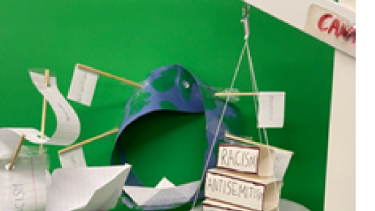
Spotlight on M.S. St. Louis Incident
Creating a New Memorial for the M.S. St. Louis Incident
Presented by: Mr. Ryan Porth
Course: Social Studies 10
TEACHER REFLECTION: This semester in my Socials 10 classes we analyzed the incident of the SS St. Louis, a ship with over 900 Jewish immigrants that sailed from Nazi Germany in 1939 seeking freedom from persecution only to be turned away from disembarking in Canada. Having been forced to return to Europe, many of the original passengers were later rounded up by the Nazis and killed during the events of the Holocaust. Students studied how anti-Semitism was a potent force in Canada’s history, influencing all levels of society, from the Prime Minister on down. We considered whether, by turning away the Jewish refugees, Canada played an indirect role in the attempted genocide of Europe’s Jews. Finally, we reflected on if Canadians today have an ethical obligation to remember this dark period of our past, and, if so, then how? Students who wished to extend their learning were given an additional question to answer: How would you convince the Halifax Port Authority, the organization that manages the current memorial to the victims of the SS St. Louis incident, to replace the current memorial with one of your own creation instead? Students’ proposals needed to be typed and presented in class and needed to include a 3-D prototype of their proposal.
The results were remarkable! Students that opted to create a prototype and a proposal put their creative services to work and made prototypes out of Lego, toothpicks, and art supplies. One student even opted to create a prototype on 3-D software and then screen capture a video “walk through” of his design. Their proposals were thoughtful and creative and demonstrated a high level of engagement with the complex issues around anti-Semitism, memory, loss, and historical judgment.
STUDENT REFLECTION: When reading, watching, and exploring the information and data surrounding the M.S. St. Louis incident, I successfully identified different perspectives of those involved and the implications various actions had. Through this, I examined and adjusted my thinking. For example, I noted how the passengers of the ship thought they were going to be free—and the German crew, even if they figured the ship wasn’t going to dock anywhere, still helped encourage the passengers and influenced the passengers’ happy moods. I am also open-minded and can interpret, judge, and make multiple conclusions with data I am given. For example, I found it interesting that the M.S. St. Louis was freely allowed to leave Germany—the Nazis didn't hold them back. I can see many reasons for why they may have done this and interpret to make judgements on the choices they made. Lastly, I know that I’m not perfect. Many times, when making my “replacement” M.S. St. Louis memorial, I reconstructed and refined, reassessed, examined, and adjusted my work. One of the things I pride myself in is recognizing the effort I’ve put into something, and whether the result is adequate or not. I can further fix my work and reflect on how to do things better next time.